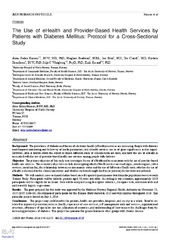| dc.contributor.advisor | Olsen, Jan Abel | |
| dc.contributor.advisor | Braaten, Tonje | |
| dc.contributor.author | Amundrød, Eli Wik | |
| dc.date.accessioned | 2012-11-27T09:31:21Z | |
| dc.date.available | 2012-11-27T09:31:21Z | |
| dc.date.issued | 2012-05-01 | |
| dc.description.abstract | Population health (measured in terms of life expectancy and under-five mor-tality rate) has improved under the era of the Millennium Development Goals. The aim of the thesis was to examine the association between population health and health care resources in poor countries, to better understand the situation and how to improve it.
I have done an ecological analysis of aggregate data. The sample consisted of 91 low- and lower-middle-income countries. Changes in life expectancy and in under-five mortality rate from 1995 to 2009 were used as dependent variables. Included as independent variables were gross national income (GNI) per capita, total health expenditures (THE) as percentage of gross domestic product (GDP), governmental expenditures as percentage of THE, external resources as percentage of THE, separate densities of physicians and nurses, and measles vaccination coverage.
The predictors of life expectancy and child mortality rate were in a large degree different. Total health expenditure (% of GDP) and external resources (% of total health expenditure) stood out as the strongest predictors.
Large increase in THE as percentage of GDP and/or large increase in the percentage of THE originating from external resources, independent of the level in 1995, was considered as the most important of the predictors of improved population health.
Keywords: life expectancy, under-five mortality rate, health care resources, GNI per capita | en |
| dc.identifier.uri | https://hdl.handle.net/10037/4636 | |
| dc.identifier.urn | URN:NBN:no-uit_munin_4351 | |
| dc.language.iso | eng | en |
| dc.publisher | Universitetet i Tromsø | en |
| dc.publisher | University of Tromsø | en |
| dc.rights.accessRights | openAccess | |
| dc.rights.holder | Copyright 2012 The Author(s) | |
| dc.rights.uri | https://creativecommons.org/licenses/by-nc-sa/3.0 | en_US |
| dc.rights | Attribution-NonCommercial-ShareAlike 3.0 Unported (CC BY-NC-SA 3.0) | en_US |
| dc.subject.courseID | HEL-3950 | en |
| dc.subject | VDP::Medical disciplines: 700::Health sciences: 800::Community medicine, Social medicine: 801 | en |
| dc.subject | VDP::Medical disciplines: 700::Health sciences: 800::Health service and health administration research: 806 | en |
| dc.subject | VDP::Medisinske Fag: 700::Helsefag: 800::Helsetjeneste- og helseadministrasjonsforskning: 806 | en |
| dc.subject | VDP::Medical disciplines: 700::Health sciences: 800::Other health science disciplines: 829 | en |
| dc.subject | VDP::Medisinske Fag: 700::Helsefag: 800::Andre helsefag: 829 | en |
| dc.title | Mortality reduction in poor countries: exploring the association with health system resources and economic growth | en |
| dc.type | Master thesis | en |
| dc.type | Mastergradsoppgave | en |


 English
English norsk
norsk



